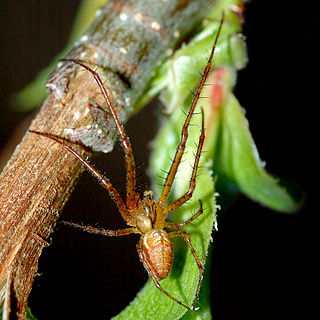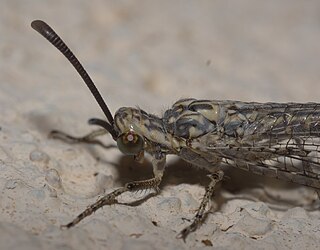Penionomus is a genus of jumping spiders that was first described by Eugène Louis Simon in 1903. As of August 2019 it contains only three species, found only in Pakistan and on New Caledonia: P. dispar, P. dyali, and P. longipalpis.

Peucetia viridans, the green lynx spider, is a bright-green lynx spider usually found on green plants. It is the largest North American species in the family Oxyopidae. This spider is common in the southern U.S., Mexico, Central America, and in many West Indies islands, especially Jamaica. Lynx spiders are hunters specialized for living on plants. This species does not use a web to capture its prey. It pounces on its prey in a cat-like manner, which is the reason for the name lynx. It is active during the day.

Metellina is a genus of tetragnathid spiders that occurs mostly in Eurasia, with two species found in North America. M. segmentata was introduced to Canada.
Catocala longipalpis is a moth in the family Erebidae first described by Rudolf Mell in 1936. It is found in Yunnan, China.

Brachynemurini is a tribe of antlions in the family Myrmeleontidae. There are about 16 genera and at least 90 described species in Brachynemurini.

Thevenetimyia is a genus of bee flies in the family Bombyliidae. There are more than 40 described species in Thevenetimyia found worldwide, mostly in North America with several species in Australia and southeast Asia.
Aradus behrensi is a species of flat bug in the family Aradidae. It is found in North America.
Aradus inornatus is a species of flat bug in the family Aradidae. It is found in North America.

Nyctelius nyctelius, known generally as the violet-banded skipper or nyctelius skipper, is a species of grass skipper in the butterfly family Hesperiidae. It is found in Central America, North America, and South America.
Largus pallidus is a species of bordered plant bug in the family Largidae. It is found in North America.

Scotoleon carrizonus is a species of antlion in the family Myrmeleontidae. It is found in Central America and North America.

Scotoleon is a genus of antlions in the family Myrmeleontidae. There are more than 20 described species in Scotoleon.
Scotoleon nigrilabris is a species of antlion in the family Myrmeleontidae. It is found in Central America and North America.
Aneurus borealis is a species of flat bug in the family Aradidae. It is found in North America.

Chimarra is a genus of little black caddisflies in the family Philopotamidae. There are more than 630 described species in Chimarra.

Peucetia longipalpis is a species of lynx spider in the family Oxyopidae. It is found in a range from the United States to Venezuela.It was first described by Frederick Octavius Picard-Cambridge in the year 1902.
Haplusia is a genus of gall midges and wood midges in the family Cecidomyiidae. There are more than 20 described species in Haplusia.
Cylindrarctus is a genus of ant-loving beetles in the family Staphylinidae. There are about 10 described species in Cylindrarctus.
Neomolgus is a genus of snout mites in the family Bdellidae. There are more than 20 described species in Neomolgus.

Lutzomyia longipalpis is a species complex of sandfly belonging to the family Psychodidae. This species is primarily present in Central and South America, but has also appeared in Mexico. There have been reports of L. longipalpis as far south as Argentina, as they are found in a wide variety of ecological conditions. Both males and females feed on sugars from plants and aphids, but only adult females feed on the blood of other mammals. The species has recently begun appearing in urban areas throughout Brazil, and serves as a key vessel for the propagation of the parasite Leishmania infantum. The presence of these flies appears to be strongly correlated to the presence of domestic chickens in Latin America. The first major urban outbreak of the lethal Visceral leishmanias epidemic was detected in Teresina, Piauí State in the early 1980s following a massive planting of acacias.









